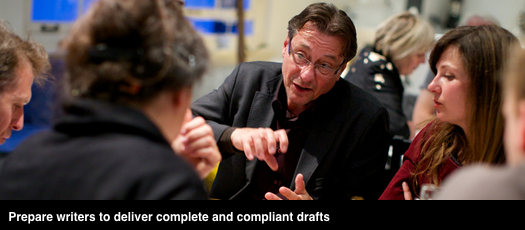This blog series explores managing large narratives. This post explains how to set up proposal writers to be successful.Most content developers are not professional writers. They typically have other responsibilities as their main focus and fit proposal writing in among those other tasks. When assigned a set of RFP questions, they’re likely to reuse existing content, borrow from supplier marketing material, or find other workarounds to avoid drafting original copy.
The most effective way to counter these inclinations is with tools and processes that establish expectations and make it easier to write compelling responses. Main items include:
Proposal strategy
Share your team’s win strategy with content developers to build coherence and consistency across sections. Aim for a document that goes beyond one-liners (We’re local! We have experience!) but is concise (one-to-three pages), so writers will read it. Include section-level win themes or strategy statements, so each writer understands how the strategy should be expressed in his or her content. For details, see this post on proposal strategy making.
Templates and prompts
A well-built template enables writers to easily understand the structure of their sections and to avoid wasting time replying to unscored questions (as often happens), omitting key points, or misunderstanding how their responses should be structured. Include defined styles for all types of content required (body copy, main heads, multiple subheads, captions, callouts, tables, two-level bullet lists, numbered lists, etc.). We’ll devote a future post to templates.
Prompts are the single most helpful tool you can give writers. Write a prompt for each question and include specifics on what constitutes a complete response and how it should be structured. For example, for the question, “Provide staffing details for the operations team,” the prompt might read: Structure this as a table, with a row for each role and columns for Responsibilities, Head count, Shifts, Reports to. Asterisk key individuals and refer in text to subsection containing resumes. If space permits, include a snippet of the org chart showing the operations team.
Style guide
We customize our in-house style guide for each opportunity, mainly for use by our editors. We provide writers with items they are most likely to use, including naming conventions and short forms for the proposal consortium and teams (Design-Build Team, etc.), RFP sponsor and reference projects; abbreviations for measurements, dates, etc., and capitalization rules. Editing time is reduced to the extent drafters observe these guidelines.
Storyboards
For tightly page-limited proposals, section storyboards can be very helpful in deciding how to use the pages allotted for responses. We use these especially in RFQ responses.
Kickoff
Take time to prepare and run a kickoff that will help writers understand the importance of the pursuit, expectations for their roles and the schedule and protocols for managing content. See this series of posts on proposal kickoff goals, preparation, people and agenda.
Organization and management tools
Although not the focus of this month’s posts, you’ll need the following two tools to manage any large proposal
- Project schedule: Include all key dates to submission, including kickoff, submission deadlines ahead of reviews, review dates, print deadlines, etc.
- ATOC: We use an annotated table of contents (ATOC) in the form of an Excel worksheet as a responsibilities matrix and deliverables tracker. A second worksheet contains contact information for all team members, and a third contains a calendar-format picture of the project schedule key dates.
Why invest this effort in preparing writers?
Properly prepared, most writers will produce compliant and responsive first drafts, which can then be managed in an orderly way to completion. Without preparation (and we see this all the time), drafts are all over the map, resulting in a small group working nights and weekends near the deadline to deliver a proposal with which no one is happy.


